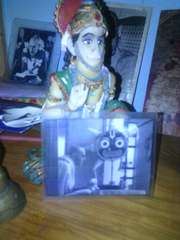Urgent questions. Drowning in our own mini maya whirl pool. :/
Hare Krsna Guru Maharaj,
Please accept our humble obeisances.
All glories to Srila Prabhupada!
We had a couple of issues that came up this week that seem pressing. Thank you for your tolerance! And thank you for your last reply Maharaj. We are not on the level to feel that we can transcend this body and even think about getting a spiritual body because we are so immersed at times by the troubles created by our own mind and body!! It is good to hear that is the goal though, thank God... At times we can differentiate that's the mind, that's the spirit soul! Usually this depends on how sincerely we are chanting and doing service.
Here is a question Maharaj, thank you very much for listening. My boss's husband Madhava Chandra and also my Bhakti Shastri teacher said I shouldn't be getting up at four because I'm not on the level of a Mahatma! Prabhu said that to do this one must take a nap during the day but if you're working full-time nine to four this is not a good idea. Please maharaj let us know if Mangal Arati and time for japa is different for the 9-4 householder bunch??
HpS - ASA - - - "Devotional service means transcendental activities. On the transcendental platform there is no contamination by the three modes of material nature. This is called viśuddha-sat-tva, the platform of pure goodness, or goodness free from contamination by the qualities of passion and ignorance. In this Krsna consciousness movement we require everyone to rise early in the morning, by four A.M.,and attend mańgala-ārati, or morning worship, then read Śrīmad-Bhāgavatam, perform kīrtana, and so forth. Thus we hold continuous activities in devotional service twenty-four hours daily. This is called sato vrtte, or following in the footsteps of the previous ācāryas who expertly filled every moment of time with Krsna conscious activities" NOI-3
Srila Prabhupada says, "everyone", here, not just Sannyasis or others.
In his presence he required the Grhasthas to also be up for Mangala arati. Krsna stopped the Rasa-lila for Mangala arati. He left Rukmni in bed for Mangala-arati.
If Prabhuji would like to write to the Blog also we could discuss the comment also.
Of course, 4AM means Brahma-muhurta, no? So this means 1-1/2 hours to 3/4 hours before sunrise. At different times in the year, in different places, this might change for 4AM to other times, but if we don't get up for Mangala arati, kirtan, Japa, SB, then we will not have enthusiasm in our daily service. We will have pure intelligence.
Of course, the contamination may ne subtle. Vyasadeva was not smoking cigarrettes or going to bars, but he still deviated, made a mistake. He presented Krsna so indirectly in the Vedas and Puranas that no one could figure understand what was he real purpose of religion.
He was not satisfied, Narada Muni, his Guru, told him that Buddha would basically have to come and deny all that he had done before SB to get things back on line.
So, yes, get up early and get your rounds done with enthusiasm.
For the devotees who were up to 10PM closing the first restaurant in ISKCON Prabhupada tod them STILL they had to get up for Mangala arati. Yes, you may have to go to bed earlier. You may have to take a nap. BhVinode Thakura was up early, but he had a nap before breakfast.
O.K?
The other question is regarding how to have patience and be excepting of the situation with St. Nicholas prabhu. Prabhu doesn't want to spend time together now and wants to act as single parents again because he says that I seem too detached when I'm around him. I have explained that I want to work on the marriage and I want to give Aja a Krsna Conscious family but he is saying that it seems I have lost respect for him and that I show it (It may be due to losing some trust). I feel very fallen in this situation Maharaj because I want to do my duty and I want to follow instructions. I understand that the problem is in my mode of how I am approaching the situation. What if we do things out of duty but our feelings and heart may not be 100 percent behind it?? Is Krsna still pleased? I'm praying for realizations so I know how to have more heart and feelings behind doing my duty and to not do something reluctantly or with my guards up. I have a hunch that to move through this my realizations need to be so so much deeper....
HpS - ASA -- Have fun. Tell him how you feel. Listen to how he feels. In NOD we remember Prabhupada saying that in the beginning there is a tendency to impersonalism because we are fried with material variety and we don't yet have spiritual reality.
So it is natural in our devotional dealings in family life this will always be there in the beginning also. We don't have this "respect", "love", based on the body of our family members: "Oh, how beautiful you (r body and singing) are!", "Oh, what big brains you have!". You have just as big a challenge to become a pure, normal, devotee of Krsna as me or Hari-vilasa or Srila Prabhupada or Queen Kunti... You are not facing small challenges, so don't be surprised that it takes time and effort, love, affection and having lots of adventure and fun. The result is eternal, absolute and all pervasive. The Supreme Lord of unlimited numbers of universes, master of all the gods, will become your personal confidant.
Nick has fre will also. His progress is also his free choice. Let's see what happens. The Soap Opera of "Kama and Nicky in Hell's Reform School!"
I pray for sincerity and good rounds so I do not get to mental about this. Thank you thank you for listening to this banter!!! We know you are very very busy.
Your fallen servant,
Kamagayatri dd
HpS - ASA -- Oink! AGTSP paoho










